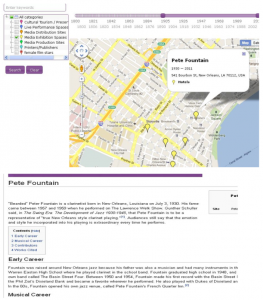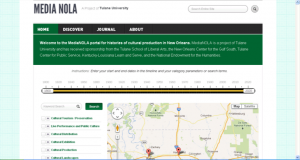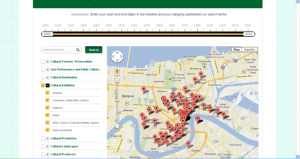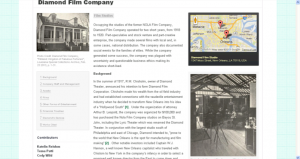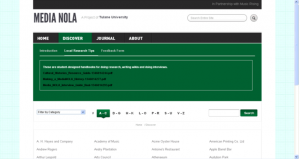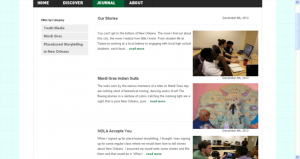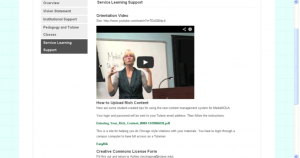MediaNOLA: A Digital Humanities Project to Tell Stories of Cultural Production in New Orleans
Vicki Mayer and Mike Griffith
The primary objective of MediaNOLA in the NEH planning grant was to work towards creating a website that showed the invisible contributions of ordinary people, places, and practices in the creation of New Orleans culture and its representations. The website was to provide an alternative way to examine New Orleans’ culture solely through the lens of its exceptionalism in relation to the rest of the United States. The scholarly impetus motivating the project came from a series of stakeholders invested in three areas of overlapping interests: (1.) the preservation of materials related to local cultures and cultural production; (2.) the public dissemination of local cultural histories that illustrated broad senses of culture and its production; and (3.) the empowerment of ordinary residents as public historians.
As the project stakeholders met and produced deliverables for the website from 2010 to 2012, it became quickly apparent that MediaNOLA’s primary objective split into two objectives that would become interdependent to the future sustainability of the project:
- The creation of website content that would demonstrate the contributions of ordinary people, places, and practices to local culture; and,
- The establishment of a pedagogic model for training university students to be creators of these contents in collaboration with community partners, including library archivists and nonprofit organizations.
Thus the need to coordinate the development of the website with the process for its creation, maintenance, and community outreach in terms of pedagogy came as a natural part of the planning process and in response to the inputs of new stakeholders in the project, especially university professors interested in deploying MediaNOLA in their classes. As a result, some of the initial goals of the grant shifted to respond to the relationship between website’s contents and the pedagogy necessary for local cultural history research, writing, and digital production. This has become an ongoing conversation among those invested in MediaNOLA and seeking its future development.
This white paper reflects on what the MediaNOLA project has achieved during the short duration of the planning grant (2010-2012), the choices taken and lessons learned, and the future plans for the project. During the course of the grant, MediaNOLA went from an idea to an actualized service learning partner for Tulane University, extending the University’s commitment to its surrounding community and a virtual community of MediaNOLA producers and users. This path provides a model for best practices when considering a project of this scope.
An Overview of MediaNOLA: Past and Present
The original intention in designing MediaNOLA in 2008 was to bring together a number of stakeholders in the preservation and connection of cultural histories from the perspectives of everyday people, places, and things. The intellectual roots of this project followed from contemporary research into invisible labor– the everyday people and sites that help generate capital for cultural industries. It was also planned as a survey of New Orleans cultural history research, which tended to focus on both the unique genius of a few individuals to a few specific cultural genres (jazz and cuisine for example). However, the motivation to start the planning process for such a wide-ranging project originated with Hurricane Katrina. Project members realized that there needed to be a coordinated effort to stem the loss of so many physical records and human articulators of the cultural past in the city. We applied for a planning grant in 2010 to devise a project that could encompass a demotic notion of culture and cultural production in New Orleans history.
MediaNOLA’s own historical transformation has occurred in a relatively short timeframe. Before the beginning of the planning grant, MediaNOLA had a wiki-based site which had been piloted in two courses: a freshman experience course on digital storytelling and an upper-level research course on media history. After the grant, the project has become an integral part of the University and its strategic goals.
Planning and the Project Team
The project team for MediaNOLA has grown and shifted over the past two years. At the time we applied for the grant, we foresaw MediaNOLA as a direct partner with a variety of community groups, such as the New Orleans Video Access Center, which were in the process of digitizing their archives. This proved to be an ambitious proposal, one that could not be coordinated in light of University resources and the needs of the faculty who would come to use MediaNOLA in their classes. The need for preservation monies among nonprofits in the city well outstripped the numbers of students eager to access them. Although MediaNOLA project leaders have done some limited digitization to address particular classes and specific collections, we realized that MediaNOLA would have to partner with these organizations for their own preservation grant processes. These would not be concluded by the end of the planning grant cycle.
Instead, MediaNOLA grew through a process of internal University needs assessments. Namely, the reorientation of the curriculum towards service-learning in the post-Katrina era created a demand for courses that could coordinate classroom research projects with publicly accessible deliverables. As a result, the project team expands each semester with the inputs of faculty from the departments of History, English, German, Studio Architecture, Music, Communication, and the interdisciplinary program housed in the New Orleans Center for the Gulf South. Each of these faculty members forge their own community partnerships with archivists and nonprofit organizations.
The ability to expand and contract project membership according to the logic of University courses and schedules has been facilitated by the leadership of staff and students involved in the Tulane Center for Public Service and law students involved in the Tulane Intellectual Property Law Clinic. These students work one-on-one with professors and rights-holders to ensure the smooth integration of MediaNOLA into University curricula and its role in making a wide variety of contents publicly accessible. The continuity of these relationships is managed primarily by a CPS staff member and the faculty director of the law clinic.
Expanding Users and Audiences
The demotic turn in terms of the organization and development of the website has meant that the project follows the paths and interests of its producers and supporters. The site has developed somewhat rhizomatically. Different stakeholders, such as teachers, independent study students, community participants, and archivists, have adapted the project to their own needs and aims. Some of the uses of MediaNOLA have involved the digitization of primary materials, the posting of field projects and ethnographic observations, and the plotting of large data sets related to film production in the city, and the development of partner sites for curating research, such as a video game and a mobile tour application called New Orleans Historical. Along the way, students created handbooks to pass learned knowledge on to future users. While in the future, these uses may become more focused, for now they have simply demonstrated the need for a tool that can handle many types of comparative evidence and can serve as a bridge in helping libraries and community organizations communicate with new publics, especially the student participants and producers.
Users currently become participants through classes at the University. Student-generated histories and their mapping are developed in accordance with content in the course, marrying a myriad of research techniques, analytic frameworks, and digital skills to a public history commitment. Publicity for the site via the Center for Public Service and other community forums have generated more interest than can currently be accommodated. Residents representing historic neighborhoods, educational nonprofits, and personal genealogy have requested MediaNOLA’s assistance in digitizing, interviewing, and archiving projects for distribution through the site.
With the new members of the planning team, MediaNOLA grew rapidly, if not exponentially. In Fall 2012, over 150 Tulane students across three different schools (Liberal Arts, Architecture, and Business) were simultaneously using and posting information to MediaNOLA. These courses ranged from entry- level first-years to graduate students. Other classes at the University of New Orleans were using the site as part of their research sources.
Links on the library research website and librarian recommendations to go to the site bring some users to MediaNOLA. We suspect, though, that most users find the site through Google searches for materials that can only be found online through the portal. We have only anecdotal evidence from user queries for more information about family members or the places that users remember visiting. Although we only recently established Google Analytics to capture the number of users on the site and their geographic locations, we hope to see the same upward trend in user numbers to reflect the upward trend in participants on the site. Analytics data gathered in the fall of 2013 show that MediaNOLA got more than 1,000 hits per month over the previous spring, summer and fall.
Important Choices and Paths Not Taken
Any digital humanities project involves a series of interlinked choices around its contents, its users, and its technologies. MediaNOLA began on a relatively small scale, with one to two classes per semester and in partnership with a few archives and community partners. As the project scaled up in terms of its scope and stakeholders, however, project leaders had to make choices about where to scale back and focus our resources.
Content Decisions
MediaNOLA began under the assumption that the site would not promote one official way of illuminating cultural production in the city. Rather the term “culture” was left purposely broad to allow for a diversity of stories about culture, its makers, places, and manifestations. This broad brush approach has been one of the selling points of the project to a variety of professors and student researchers who have been able to adapt the site to their own ends. In other words, by not defining what is cultural, who are producers of a culture, and where culture is located, MediaNOLA has allowed for the democratic inclusion of a range of materials that might have otherwise never been preserved. The classes using MediaNOLA span freshman intro courses to graduate seminars. These classes are housed in the Schools of Liberal Arts, Architecture and Business, and their learning objectives range from drawing historical floor plans, to learning how to read archival resources, to conducting oral histories. The results of their work, found on MediaNOLA, provide a tapestry of approaches to culture knowledge and authorship.
At the same time, we have had to become more vigilant with the accuracy of our historical narratives and data. Although individual faculty are responsible for the quality of MediaNOLA entries, not all errors are obvious, even to trained professors who may not be familiar with every citation in a research paper. It also became apparent that some histories were more initial impressions or reflections on a cultural topic. For example, many of the first-year courses focus on personal experiences in the city rather than research or the application of a particular research method. To meet these challenges, MediaNOLA took two approaches. First, the project director now hires student editors who fact-check and correct entries as they come into the system. These are students who have proven themselves as effective contributors to MediaNOLA or have particular skills (for example reading Sanborn maps) that the project needs. Second, the project launched a “journal” page in the platform. This is an open blog that cross-references the historical entries but allows more freedom for single-author reflections without necessarily citing factual sources or community members.
Despite these efforts, there will always be a tension in the project between what makes an authoritative history and the role of replicable evidence in the form of citations. Like research papers, we have not been immune from student plagiarism and other research short-cuts that deter original contributions. We believe this is a productive tension from a pedagogic standpoint, though it may turn off some users, particularly researchers invested in particular narrative forms and evidentiary sources.
Pedagogic Choices
By becoming an official service learning organization, MediaNOLA has become integrated into the University’s service learning curriculum and its mission for community engagement through classrooms, independent research projects, and community-based internships. This was a decision that recognized that MediaNOLA would be part of a pedagogic strategy that trained students to be amateur public historians, ethnographers, folklorists, preservationists, and archivists, while, at the same time, sharing our research products with the public. MediaNOLA allows students multiple points of entry to gain different skills associated with these professional roles, but also allows them a relatively safe space in which they can experiment with different ways of codifying histories and collaborative research. Different kinds of projects have produced a menu of options for faculty and students to select a project that builds on students’ abilities at the appropriate level.
Even if contents for MediaNOLA are pluralistic, the participants in the project are not necessarily diverse. The majority of participants who enter histories into the database are Tulane University undergraduates who encounter MediaNOLA as a class project. These projects may include trips to an archive or community-based interview projects, but the students, most of whom do not come from New Orleans, are the ones charged with representing local culture through their stories. Again, the burden is on individual professors and mentors to guide students’ inputs into MediaNOLA. Faculty who have expected their students to become skilled ethnographers simply by attending a second-line parade have been disappointed by the touristic gaze that infuses the students’ MediaNOLA entries. Conversely, faculty may decide not to teach alternatives to these outsider perspectives on culture simply because they feel time pressures and the need to simply validate students’ first impressions. In these cases, we have to wait for future classes and/or students to add more layers and complexities to the original stories that are told. In this case, we hope the extensive online guides and manuals that the NEH supported will help faculty not only navigate MediaNOLA, but also give them more freedom to develop assignments that would rectify past errors and develop more varied stories about local culture.
For better or worse, MediaNOLA’s role as a service-learning partner means that the sustainability of the project relies on the networks of partnerships it has developed within Tulane University, first, and between Tulane and the New Orleans community, second. That is, MediaNOLA serves community group needs via the service learning classes that elect those groups as partners and then decides that MediaNOLA is the platform for disseminating the outcomes of the partnership. This is the way that MediaNOLA works indirectly with a range of community groups and nonprofit institutions. Although MediaNOLA has been approached by several community organizations in search of our student researchers over the past two years, it has not been sought for direct access to the platform itself. This can be attributed to the relatively well-developed infrastructure at the University and the lack of resources and staffing of potential community partners, particularly in the post-Katrina era. Once these University partnerships are stabilized through a regularly offered menu of courses, it will make sense for MediaNOLA to be able to satisfy community nonprofits’ needs more directly in the future.
Technological Choices
The platform and software are among the most complicated set of choices for a digital humanities project, particularly at a university such as Tulane that lacks many in-house programming resources. While MediaNOLA had developed a productive MediaWiki instance in-house in 2009 for the collection of the historic content, the search and mapping interface proved more challenging. The platform would need to allow for flexible expansions, revisions, and adaptations to faculty and community needs; while remaining simple enough for users to enter their materials without having to master markup languages that would add another level of complexity to the instruction necessary in a typical MediaNOLA course.
Our original prototype for tying together the wiki and GIS data was short-lived as it quickly presented its own shortcomings. The Codex system was developed by a graduate student at UT-Austin for another mapping project called Austin Memory Project. Grant funds subsidized the graduate student to develop a version of Codex for Tulane as well as to release the program as open source software. Unfortunately this partnership was broken by the Codex team and the MediaNOLA project was forced to find a new home. While MediaNOLA was partnered with Codex, content was basically divided over two sites. The MediaNOLA.org site was the home of Codex and the GIS data, while MediaNOLA.tulane.edu was home to the MediaWiki site which housed the historical narratives. Each media site was cataloged in both places with links passing the user from one to the other. During this time, we piloted the program in two classes, an upper division course in media history and a freshman experience course in digital storytelling. The prototype failed on several measures. First, the Austin Memory Project, which cross-referenced census and phone book data in a searchable map, was not compatible as a model for public history mapping and storytelling. Our users expected better design and fewer bugs on the front end. It became clear that many users were entering the site through the wiki and missing the connection to the GIS data entirely. Second, as the two sites were based on different platforms, the students entering data had to learn two different processes. This became unwieldy for professors and students who wanted a one-stop shop for their class projects. Finally, the reliance on an external member of the team for technological development created some difficulties in executing the project’s mission. From the perspective of Codex team the time spent in developing the program was too tempting not to move it into the commercial market. The MediaNOLA team was left with a buggy platform and restricted access to the remote project team. Given the challenges in the classroom, we needed a quick solution to transfer the XML data to a more stable program before the fall 2012 semester classes began. Data was extracted from Codex and a new team was commissioned to develop a platform which would incorporate the historical and GIS plotting features of Codex with the standard versioning and contribution tools of MediaWiki.
At that point, our saving grace came from within Tulane and its new initiative for the New Orleans Center of the Gulf South (NOCGS). Funded by alumni donations, the Center has strived to have students contribute to a website about regional musical cultures. MediaNOLA’s archive of music club and music industry histories was perfectly suited for the NOCGS site, which will be called Music Rising and is still under development as of October 2013. This collaboration allowed MediaNOLA to be relaunched in August 2012 using the same locally-made programming platform and software as Music Rising. Although the new system has the occasional bug, its stability has allowed program members to focus on content and pedagogy over the complex technical decisions that required a staff programmer. Unfortunately, it is a proprietary program, thus limiting the transferability of the project to other organizations.
In making choices about content, pedagogy and technology, we have come to see how MediaNOLA has matured as a project that integrates the digital humanities with service learning. Ultimately this has been a process of discovery. The nature of the content to be collected by students for the MediaNOLA environment was of a mostly theoretical nature when the platform was designed and launched. It was in the creation of cultural histories and other contents that the needs of the system came fully to the forefront. When this process is combined with the different pedagogical approaches of the faculty employing the platform in their classes, the growing pains explicated above are seen to arise as a natural progression of the collaborative process. The version of MediaNOLA that consisted of the combination of Codex and MediaWiki was the 1.0 version that allowed for the proper delineation of requirements for the custom 2.0 platform that has come to replace it.
Accomplishments of the Planning Grant
Once we realized the demand for a digital humanities platform that could respond flexibly to a wide range of contents about local cultural history, practices, stories, and audiovisual documents, the MediaNOLA team worked to develop the most appropriate materials for training faculty, students, and staff in using the website appropriately and effectively. At the same time, the team has responded to that primary audience by developing digital capabilities that we did not foresee at the time we applied for the NEH grant. These include:
- A journal section for student reflections in the service-learning process;
- An orientation video explaining the history, mission, and vision for the site and its participants along with downloadable instructions for using MediaNOLA’s CMS. The video was prepared in conjunction with Tulane’s Faculty Technology Lab;
- A handbook on conducting interviews with community members along with a series of videos about the ethical issues involved in community interviewing. These were compiled by NOVAC from a community documentary seminar in Fall 2011;
- A downloadable research guide for using local archives, including relevant finding aids for MediaNOLA projects;
- A creative commons agreement (PDF) for MediaNOLA authors and interviewees to protect participants’ contributions from theft while also encouraging future fair use of the materials. These materials were prepared by the Tulane Intellectual Property Law Clinic and approved by University General Counsel;
- Teaching handouts for uploading and formatting contents;
- Tips for history writing;
- A pedagogic philosophy for using MediaNOLA in the classroom along with sample syllabi assignments geared to appropriate learning levels.
MediaNOLA 2.0 (the site as it exists now) is a fully integrated content management system and GIS repository. The site allows for student users to create entries for media sites and build custom content and citations related to the selected site. The content entry system mirrors that of MediaWiki in most ways including version and citation tracking. Students are also able to locate their media sites through a simple Google maps search, the coordinates of which are then fed into the custom mapping system where they can be searched by location and date. Faculty users have the ability to monitor their students in terms of the work they are doing as well as the revisions they are making. One of the advantages of the wiki environment is that a substantial amount of data has been collected on the process of writing media histories from the student perspective. This data includes types of citations used, revisions made and the process by which the form of the narrative comes together. We have only just begun to mine this data for its full pedagogical implications and long-term impacts.
Finally, MediaNOLA has created viable bridge with fellow digital humanities initiatives in the city. Our partnership with the New Orleans Center for the Gulf South became a turning point that has enriched both the MediaNOLA project, and the Center’s Music Rising initiative to bring a New Orleans musical cultures curriculum into K-12 schools. We share a platform that will enable easy sharing of our contents. In Fall 2012, we became the repository for the data gathered in the Crossroads project, another web-based project maintained by an adjunct professor of architecture after the storm. In Spring 2012, MediaNOLA partnered with a faculty member at the University of New Orleans to launch New Orleans Historical, a mobile app developed by the founders of Cleveland Historical. We currently host interns from the Collat Media Internship Project, a Tulane initiative to train women in new media and technology development. Working together, MediaNOLA contents can be curated in new and dynamic ways.
Evaluation
MediaNOLA is finally entering the lexicon of the University and has made some inroads into the knowledge base of the general public. The primary audiences thus far have been at Tulane (professors and faculty) but anecdotally, we know that researchers studying New Orleans come to the site as part of their scan of local resources. Archivists and librarians often will tell us they recommend the site to researchers. Staffers at the Louisiana Endowment for the Arts have told us that our site has better sourcing and evidence than Wikipedia sites for New Orleans culture. In addition to this, project members are just starting to do research presentations on MediaNOLA, which has enlarged our scholarly audiences and researcher networks.
The primary evaluators of the project have been the hundreds of students and professors who have worked with MediaNOLA over the past 21 months in the context of their course objectives. These have been evaluated through regular course evaluations, though the response rates to these institutional reviews have been very low overall (about 25% or 42 of 166 surveyed). The mean score that MediaNOLA received for these students was a 3 out of 5 for a general question about the service learning experience overall, and not MediaNOLA. In response, staff and participants have tried to create alternative opportunities for feedback, such as a recent evaluation “happening” in which participants can meet each other and post their reactions and advice to future users about participation in the project.
One outside evaluator Steve Zeitlin of the groundbreaking public history project City Lore provided us with invaluable feedback as we move forward with MediaNOLA. We quote his review here as it highlighted for us one of our real accomplishments, which is sustainability:
Most important, MediaNola has a quality which distinguishes it from most all of the virtual mapping initiatives with which I am familiar – it offers a model for sustainability. The project is rooted in Tulane University’s post-Katrina insight that the University’s fortunes are tied to those of the city itself. In response, the university instituted two credits of community service for every student as a requirement for graduation. Working with MediaNola helps students fulfill that requirement in an array of disciplines, and provides MediaNola with students and interns who can contribute to the project in an ongoing basis. Whereas most virtual mapping projects create a web site with no plan for the kind of labor required to sustain the site and keep it vital, MediaNOLA has a sustainable strategy and a bright future.
Best Practices Moving Forward
If anything this project has revealed the importance of strong partnerships at the outset of a digital media project, especially with regard to the creation of pedagogical goals and ideals. Our integration with the service learning curriculum, our ability to respond to faculty and community needs through training material and new digital capacities makes for not only a demotic approach for preserving history but one for training a generation of students as researchers, engaged community workers, and authors.
Along the way, we’ve also learned to pay attention to the different aspects of a good web platform. We did not pay enough attention to the aesthetics (the ‘look’) of the site in the early stages. Today, we are working with a geographer and cartographer to encode our own map overlay for the front page in order to promote our own identity and get away from the identity associated with Google maps. We also had to learn how to balance student voices as authors with the traditional forms of academic legitimacy and copious citation. As a result we’ve become more stringent with the formatting of contents and their citation, while allowing for different forms of subjectivity and detachment to be present in the stories themselves.
We are still seeking the best ways to evaluate our ongoing performance. The platform as designed or selected is capable of tracking significant metrics across the breadth of the project. Yet, we also find that some of the best feedback has resulted from our publicity campaigns. Social media (Facebook, Tumblr, Twitter) and public lectures (TEDx and Tulane Digital Trends) not only introduce new audiences to the site but encourage their feedback. We can see what contents get passed on through social media networks and repostings. Time will tell how to best integrate responses from different types of users.
We also realized that MediaNOLA has to be part of an emerging digital landscape in the city’s post- Katrina era. Many projects have come and gone for lack of funding and a renewable social network of users and audiences. MediaNOLA has successfully modeled how to work with other digital projects. We want to continue to find ways to build bridges with other institutions, both among universities and with other types of educational institutions, such as the Louisiana Endowment for the Humanities and local museums. A digital humanities network, enriched by community engagement research, would ensure that our cultural histories and memories do not wash away with the next storm.
Originally Published by Vicki Mayer and Mike Griffith in March 2013.
Appendix A: Images of Completed Work Samples
The NEH programming expenditure was used in making this prototype website, which was available December 2010-August 2012. It was too complicated to contribute to, had many bugs (see automatic dating of Pete Fountain’s death in the map), and lacked curb appeal:
This prototype became the model for the present-day website, launched in August 2012:
This is a close-up of a map search on MediaNOLA:
This is a close up of a MediaNOLA history of the Diamond Film Studios (1918-1920):
These are the handbooks for doing local archival research, history writing, and oral interviews:
This is the new journal launched for first-person storytelling and reflections about culture in the city:
These are the resources for service-learning classes, including the orientation video, how-to handouts, and creative commons licenses:
Appendix B: Pedagogy, Courses and Independent Projects Using MediaNOLA:
As part of our decision to publicize MediaNOLA as part of a pedagogic strategy of engaged learning, we posted the following to the site:
Pedagogy and Tulane Classes
Beyond its function as a destination website, MediaNOLA is a pedagogic tool for training amateur historians, researchers and preservationists. MediaNOLA permits reflection on exceptional histories of New Orleans culture dialectically through the website’s content and the pedagogy of its use as a teaching and research tool. In other words, as participants conduct research and post more content, the collective and additive process creates a larger mosaic for interpreting culture in multiple ways. Specific assignments for MediaNOLA match both the reflective process and creative engagement as proposed by the University’s service learning standards.
The first interactions with the site involve using it to log and describe an everyday cultural place or artifact. This process registers the historical legitimacy of the object of study and allows the participant creative freedom to select its attributes and connections across categories of cultural performance, exhibition, distribution, and production. Students in classes follow this assignment with a simple reflection describing their process and questions they have about this object in relation to curricular materials.
Subsequent assignments may involve a number of creative engagements with the object or the people, places, and other objects that are linked to it by category or theme. For example:
- Use historical newspaper archives to find out about the places, people, and objects found in your scrapbook for that particular time period. Create and add to MediaNOLA pages about these items and connect to your description of the scrapbook.
- Use city directories to locate other businesses like the one you have written about.
- Add GIS entries to MediaNOLA to show the way your place was either uniquely located or clustered with others during its years as a cultural place.
- Present a list of MediaNOLA pages to a person who has lived in the city at least two decades. Ask a person to describe their personal memories of any object he or she selects from the list. With their permission, record, edit and post this memory to that MediaNOLA page.
- Go to the place you have described and interview different people who work or participate in that space. With their permission, collect at least three different ways that people see this place as part of the cultural history of the city.
Whereas the initial interaction with MediaNOLA positions users as participants, the second level of interaction deepens their engagement as amateur historians. The proper use of citation and permission to use people’s voices is an important way that participants, not least of all those not familiar with the city, can gain proximity to the historical enterprise and a shared authority over historical knowledge. The assignments urge students to reflect about what is unique or common to local cultural products, producers, and places. The totality of locations and people included by the collectivity of participants forces students to recognize culture as a demotic production that spans the urban geography.
A final set of assignments encourage students to take the historical content in MediaNOLA and rework it to adapt new evidence and perspectives. Some examples of these assignments include or combine:
- Take a MediaNOLA history and rework it using five additional sources from your library archives.
- Take a MediaNOLA history and rework it to include the perspective(s) of local interviewees.
- Use secondary sources and course readings to give the historical context to a MediaNOLA entry in terms of gender, race, and/or class conditions in the city. Rewrite the history to consider the standpoint(s) of the historian in the MediaNOLA history.
This is the most advanced stage in the MediaNOLA pedagogy. It engages participants not only in questions of their own distance and proximity to the evidence they encounter, but also how to balance these implicit standpoints into a unified narrative with coherent sections. Curating in this environment becomes what Fiona Cameron and Helena Robinson call knowledge brokering (2007, p. 185), making all voices heard even if arranged hierarchically according to the evidence and analysis. Group-based assignments challenge students to negotiate their own interpretations of the materials into a narrative that allows for polyphony. Reflections about the research and decision-making process of being an amateur historian may reveal the tensions implicit in assuming historical authority and authorship. In a theoretical sense, the students practice post-foundationalism, which according to Mark Bevir (2011) prefaces the consonance between past and present, fact and narrative. From a postfoundational model, MediaNOLA participants begin to ask different ethical questions of historical narratives, such as: What is the legitimacy of reading our ideas into the values and actions of people in the past? At some point, the juxtaposition of competing accounts may indeed destabilize the master narratives about local culture, specifically by situating different authors’ standpoints through and with the textual layers in MediaNOLA.
Not all classes are suitable for each stage of the MediaNOLA pedagogy. Introductory courses may never reach the final stage of the pedgagogy. Advanced classes may focus primarily on the final two stages. Independent studies may focus on one stage alone.
The following Tulane classes have used MediaNOLA:
- TIDE-1760 Narratives New Orleans Digital Storytelling
- TIDB-1010 More Than Just Business
- COMM-1000 Introduction to Communication Studies
- DSGN-2100 Architecture Studio
- MCGS-2000 Introduction to the Music Cultures of the Gulf South
- COMM-3280 Media Histories
- ENLS-3620 Workshop Creative Writing: Place-Based Storytelling
- AHST-4199 Sites/Sounds: Public History
- HISU-6610 The Old South

